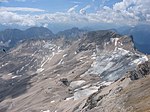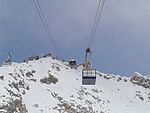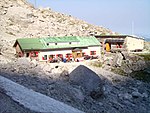Wetterwandeck
Garmisch-Partenkirchen (district)Mountains of BavariaMountains of Tyrol (state)Mountains of the AlpsTwo-thousanders of Austria ... and 2 more
Two-thousanders of GermanyWetterstein

The Wetterwandeck is a summit, 2,698 m high, in the Wetterstein mountains on the Austro-German border. It is located south of Germany's highest peak, the Zugspitze, above the Southern Schneeferner in the ridge which borders the Zugspitzplatt to the south. The first verifiable ascent of the Wetterwandeck was in 1874 by Hermann von Barth.A drag lift in the ski region on the Zugspitzplatt below the Wetterwandeck was named after the mountain. There is also a piste at the southern foot of the mountain known as the Ehrwalder Almbahnen.
Excerpt from the Wikipedia article Wetterwandeck (License: CC BY-SA 3.0, Authors, Images).Wetterwandeck
Gletscherrundweg,
Geographical coordinates (GPS) Address Nearby Places Show on map
Geographical coordinates (GPS)
| Latitude | Longitude |
|---|---|
| N 47.398055555556 ° | E 10.976944444444 ° |
Address
Wetterwandeckbahn
Gletscherrundweg
82475
Bavaria, Germany
Open on Google Maps











